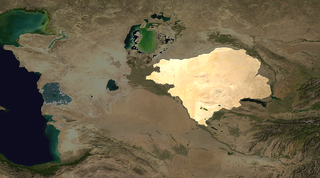
The Kyzylkum Desert is the 15th largest desert in the world. Its name means Red Sand in Turkic languages. It is located in Central Asia, in the land between the confluent rivers Amu Darya and Syr Darya, a region historically known as Transoxania. Today it is divided between Kazakhstan, Turkmenistan and Uzbekistan. It covers about 298,000 km2 (115,000 sq mi).

Richardoestesia is a morphogenus of theropod dinosaur teeth, originally described from the Late Cretaceous of what is now Canada, the United States and Kazakhstan. It currently contains two species, R. gilmorei and R. isosceles, and a possible third, R. asiatica. It has been used as a morphotaxon to describe other theropod teeth widely displaced in time and space from the type species. If all teeth assigned to the genus are truly reflective of the animals biology and taxonomic state, it would have been one of the longest lasting dinosaur genera, perhaps also being the most widely distributed.

Tapejara is a genus of Brazilian pterosaur from the Cretaceous Period. Tapejara crests consisted of a semicircular crest over the snout, and a bony prong which extended back behind the head. It was a small pterosaur, with a wingspan of approximately 1.23–1.3 metres (4.0–4.3 ft).

The Bayan Shireh Formation is a geological formation in Mongolia, that dates to the Cretaceous period. It was first described and established by Vasiliev et al. 1959.

Arstanosaurus is a genus of hadrosauroid dinosaur from the Santonian-Campanian-age Upper Cretaceous Bostobe Formation, Kazakhstan. It has had a confusing history, being considered both a hadrosaurid and a ceratopsid, or both at the same time (chimeric).
Asiamericana is a dubious genus of coelurosaur known only from isolated teeth found in the Bissekty Formation of Kazakhstan. It was named to recognize the occurrence of similar fossil teeth in Central Asia and North America. These regions once formed a connected land mass, during the Cretaceous period.

Anurognathidae is a family of small, short-tailed pterosaurs that lived in Europe, Asia, and possibly North America during the Jurassic and Cretaceous periods. Five genera are known: Anurognathus, from the Late Jurassic of Germany; Jeholopterus, from the Middle to Late Jurassic of China; Dendrorhynchoides, from the Middle Jurassic of China; Batrachognathus, from the Late Jurassic of Kazakhstan; and Vesperopterylus, from the Early Cretaceous of China. Bennett (2007) suggested that the holotype of Mesadactylus, BYU 2024, a synsacrum, belonged to an anurognathid, though this affinity has been questioned by other authors. Mesadactylus is from the Late Jurassic Morrison Formation of the United States. Indeterminate anurognathid remains have also been reported from the Middle Jurassic Bakhar Svita of Mongolia and the Early Cretaceous of North Korea.

The Nemegt Formation is a geological formation in the Gobi Desert of Mongolia, dating to the Late Cretaceous. The formation consists of river channel sediments and contains fossils of fish, turtles, crocodilians, and a diverse fauna of dinosaurs, including birds.

Noripterus is a genus of dsungaripterid pterodactyloid pterosaur from Lower Cretaceous-age Lianmuqin Formation in the Junggar Basin of Xinjiang, China. It was first named by Yang Zhongjian in 1973. Additional fossil remains have been recovered from Tsagaantsav Svita, Mongolia.
Paleontology or palaeontology is the study of prehistoric life forms on Earth through the examination of plant and animal fossils. This includes the study of body fossils, tracks (ichnites), burrows, cast-off parts, fossilised feces (coprolites), palynomorphs and chemical residues. Because humans have encountered fossils for millennia, paleontology has a long history both before and after becoming formalized as a science. This article records significant discoveries and events related to paleontology that occurred or were published in the year 1986.
The Bostobe Formation is a geological formation in Qaraghandy & Qyzylorda, Kazakhastan whose strata date back to the Late Cretaceous.
Energosuchus is an extinct genus of rauisuchian. Fossils are present from the upper Karyomayol and lower Synya Formations outcropping along the banks of the Bolshaya Synya river in the Timan-North Urals region in northern European Russia, as well as from the Bukobay Formation in the southern part of Bashkortostan in the southern Urals of European Russia. Both localities date back to the Ladinian stage of the Middle Triassic.

Patagopterygiformes is an extinct group of large terrestrial ornithuromorphs from the Late Cretaceous of South America. It contains at most three genera: Patagopteryx, Alamitornis and possibly Kuszholia.
The Luohandong Formation is an Early Cretaceous geologic formation of the Ordos Basin in Inner Mongolia, China. The formation was initially dated to the earliest Cretaceous; Valanginian to Barremian, but later dating established an Aptian to Albian age. Dinosaur remains are among the fossils that have been recovered from the formation. Pterosaur fossils have also been recovered from the formation.
The Tsagaantsav Formation, Tsagantsab Formation or Tsagan-Tsab Formation is an Early Cretaceous geologic formation in Mongolia. Indeterminate sauropod and psittacosaurid remains have been recovered from the formation. Remains of the pterosaur Noripterus, which were originally given their own genus, "Phobetor" have also been recovered from the formation.
The Hasandong Formation is an Early Cretaceous geologic formation in South Korea. It has been dated to the late Aptian and earliest Albian, between 118.0 ± 2.6 Ma and 112.4 ± 1.3 Ma. Dinosaur remains diagnostic to the genus level are among the fossils that have been recovered from the formation. Tracks of the pterosaur ichnospecies Pteraichnus koreanensis have also been recovered from the unit.
The Khodzhaosmansk or Khodzhaosman Formation is an Aptian to Albian geologic formation in Kyrgyzstan. Dinosaur remains and fossil dinosaur eggs have been reported from the formation.
The Ialovachsk or Yalovach Formation is a geologic formation in Kyrgyzstan, Tajikistan and Uzbekistan dating to the Santonian age of the Cretaceous period.
The Dushihin Formation is an Early Cretaceous (Aptian) geologic formation in the Övörkhangai Province of Mongolia. The formation preserves fossils of Psittacosaurus mongoliensis and fossil eggs described as Trachoolithus faticanus.









